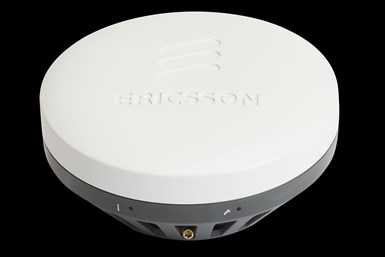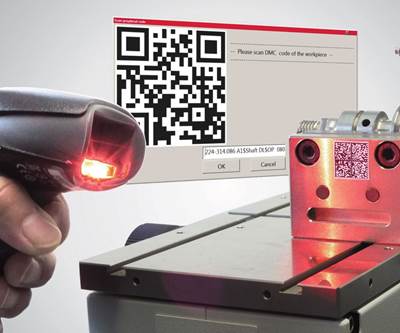Wires Make the World Wireless
Leveraging 5G requires infrastructure grounded in physical wiring and thinking grounded in practical application.
Share





You might notice a “5G” icon in the upper corner of your phone display, but did you know that 5G could potentially be applied in virtually every corner of the machine shop? In fact, the impact could be more direct and substantial for manufacturing than for the masses of consumers touting new, 5G-enabled mobile devices.

Ericsson uses “radio dots” like this one to spread both 4G LTE and 5G coverage throughout a facility. The infrastructure integrates seamlessly, enabling manufacturers to start with 4G/LTE and use 5G only for applications that require it. Photo Credit: Ericsson
Coming to this conclusion took me a while. I had read plenty about what fifth-generation wireless communications standards might mean for manufacturing before encountering what I needed to cover the subject in Modern Machine Shop: practical, shop-floor application that proves 5G’s promise not just for the industry, but for CNC machining businesses in particular. What I encountered – automatic compensation for machining vibration and tool wear while the spindle turns – convinces me beyond a doubt that at least for our sector, all the hype may well be justified.
Granted, predictions about driverless cars and remote-controlled surgery can seem breathless at a time when 5G is still emerging. One practical challenge is the fact that wireless signals do not remain wireless. They eventually move into the physical infrastructure of a network, which relies largely on fiber-optic cables. The best 5G connections require this underlying infrastructure to be dense, with more antennas and base stations to cover a given area compared to other varieties of wireless coverage. Costs and regulatory concerns can stand in the way.
At the root of this challenge is the characteristic that makes 5G different from 4G and other wireless systems: the use of higher frequency wavelengths. Higher frequencies improve bandwidth (in an often-cited analogy, this is the “width of the pipe” linking one point to another) and latency (the rate of flow within the proverbial pipe). However, the signal range decreases as frequency increases. Higher-frequency signals also have more difficulty penetrating walls and other physical barriers. No cable infrastructure, no sci-fi-like connection.
Luckily for consumers, dramatically faster downloads do not require a sci-fi-like connection. This is why 5G networks do not always use the highest “millimeter-wave” frequencies, instead relying on mid-range frequencies that still exceed the performance of previous-generation 4G/LTE networks. 5G is also designed to integrate seamlessly with 4G/LTE rather than replace it, lessening the challenge of extending the infrastructure.
In any case, manufacturing is different in all of these respects. Wireless manufacturing applications like the ones I wrote about do require ultra-fast, and more importantly, ultra-reliable data transmission. What’s more, manufacturers and other businesses can invest in their own, private infrastructure to provide the necessary capability. For them, the challenge of “the last mile” – achieving that final connection between the user’s device and the nearest cell tower – is not as much of a concern.
At the Fraunhofer Institute for Production Technology, the facility conducting the chatter-compensation research, signals from the workpiece-mounted accelerometers and other shop-floor and machine tool sensors are collected by a web of puck-like antennas on the ceiling. The “webbing” consists of physical wiring linking various pre-processing units, which combine and structure the different types of data into formats that are usable by various computing systems.
This is essentially the same kind of infrastructure that underlies previous-generation 4G/LTE networks. In fact, whether on a private or public network, the two standards are built to work side by side, with 5G handling only applications that require it. For manufacturers, this is ideal for testing and prove-out purposes. It also means that an unconnected shop can start laying groundwork now for capability to come. Manufacturers with existing wireless networks will be better prepared, but only if they are prepared to see the real opportunity in all the hype.
The research discussed in my more detailed article about 5G proves that this opportunity is real, and real for CNC machine shops specifically. The testing moves the discussion about 5G beyond vague, forward-looking talk of digital twins, digital threads, and “smart” technology and brings it down to the level of cutting tool meeting metal. In the face of both extreme cheerleading and extreme naysaying about 5G, it illuminates a path ahead that is grounded in real-world application, just as the wireless network itself is grounded in physical wiring.
Related Content
Can Connecting ERP to Machine Tool Monitoring Address the Workforce Challenge?
It can if RFID tags are added. Here is how this startup sees a local Internet of Things aiding CNC machine shops.
Read MoreFour Questions (& Answers) About Data-Driven Process Improvement at CNC Job Shops
How can shops can make informed decisions using data-driven feedback to improve shopfloor efficiency and profitability? And how will these technologies differ between high- and low-volume production?
Read MoreEasy-To-Install Data Acquisition System for Real-Time Monitoring Across Brands
cnSEE from All World Machinery Supply combines easy installation and monitoring across multiple machines.
Read MoreSwiss-Type Control Uses CNC Data to Improve Efficiency
Advanced controls for Swiss-type CNC lathes uses machine data to prevent tool collisions, saving setup time and scrap costs.
Read MoreRead Next
Video: What Will 5G Mean for Machining?
Faster wireless data transfer could bring new possibilities to machining processes. Modern Machine Shop’s "Data Matters" columnist Matt Danford talks about the manufacturing role for 5G.
Read MoreA New Quality Standard You Need to Know About
The Quality Information Framework (QIF) helps connect product data with process data in emerging data-driven environments.
Read MoreCord Cutting and Code Reading Make Gaging Smarter
Many companies have “cut the cord” to streamline metrology operations and data management. Barcode scanning is an additional option.
Read More






























